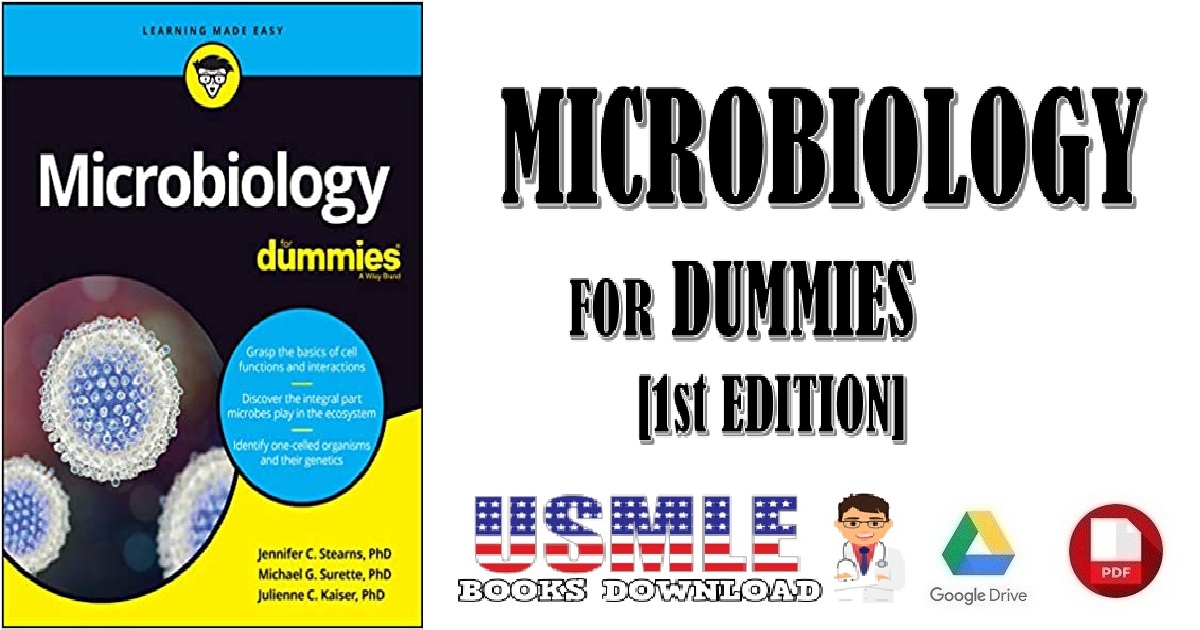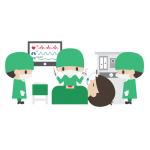In this article, we are sharing with our audience the genuine PDF download of Microbiology For Dummies 1st Edition PDF using direct links which can be found at the end of this blog post. To ensure user safety and faster downloads, we have uploaded this .pdf file to our online cloud repository so that you can enjoy a hassle-free downloading experience.
Here, at the USMLE Books Download, we believe in quality and speed which are a part of our core philosophy and promise to our readers. We hope that you people benefit from our blog! 🙂 Now before we share the free PDF download of Microbiology For Dummies 1st Edition PDF with you, let’s take a look at a few of the important details regarding this ebook.
Table of Contents
Overview
Checkout the complete overview of the book Microbiology For Dummies 1st Edition PDF:
Microbiology is a fascinating field that explores life down to the tiniest level. Did you know that your body contains more bacteria cells than human cells? It’s true. Microbes are essential to our everyday lives, from the food we eat to the very internal systems that keep us alive. These microbes include bacteria, algae, fungi, viruses, and nematodes. Without microbes, life on Earth would not survive. It’s amazing to think that all life is so dependent on these microscopic creatures, but their impact on our future is even more astonishing. Microbes are the tools that allow us to engineer hardier crops, create better medicines, and fuel our technology in sustainable ways. Microbes may just help us save the world.
Features of Microbiology For Dummies 1st Edition PDF
Here’s a quick overview of the essential features of this book:
Microbiology For Dummies is your guide to understanding the fundamentals of this enormously-encompassing field. Whether your career plans include microbiology or another science or health specialty, you need to understand life at the cellular level before you can understand anything on the macro scale.
- Explore the difference between prokaryotic and eukaryotic cells
- Understand the basics of cell function and metabolism
- Discover the differences between pathogenic and symbiotic relationships
- Study the mechanisms that keep different organisms active and alive
Table of Contents
Below is the full table of contents offered inside Microbiology For Dummies 1st Edition PDF:
Introduction
Part 1: Getting Started With Microbiology
Chapter 1: Microbiology and You
Why Microbiology?
Introducing the Microorganisms
Deconstructing Microbiology
Chapter 2: Microbiology: The Young Science
Before Microbiology: Misconceptions and Superstitions
Discovering Microorganisms
Debunking the myth of spontaneous generation
Improving medicine, from surgery to antibiotics and more
Looking at microbiology outside the human body
The Future of Microbiology
Exciting frontiers
Remaining challenges
Chapter 3: Microbes: They’re Everywhere and They Can Do Everything
Habitat Diversity
Metabolic Diversity
Getting energy
Capturing carbon
Making enzymes
Secondary metabolism
The Intersection of Microbes and Everyone Else
Part 2: Balancing the Dynamics Of Microbial Life
Chapter 4: Understanding Cell Structure and Function
Seeing the Shapes of Cells
Life on a Minute Scale: Considering the Size of Prokaryotes
The Cell: An Overview
Scaling the Outer Membrane and Cell Walls
Examining the outer membrane
Exploring the cell wall
Other Important Cell Structures
Divining Cell Division
Tackling Transport Systems
Coasting with the current: Passive transport
Upstream paddle: Active transport
Keeping things clean with efflux pumps
Getting Around with Locomotion
Chapter 5: Making Sense of Metabolism
Converting with Enzymes
In Charge of Energy: Oxidation and Reduction
Donating and accepting electrons
Bargaining with energy-rich compounds
Storing energy for later
Breaking Down Catabolism
Digesting glycolysis
Stepping along with respiration and electron carriers
Moving with the proton motive force
Turning the citric acid cycle
Stacking Up with Anabolism
Creating amino acids and nucleic acids
Making sugars and polysaccharides
Putting together fatty acids and lipids
Chapter 6: Getting the Gist of Microbial Genetics
Organizing Genetic Material
DNA: The recipe for life
Perfect plasmids
Doubling down with DNA replication
Assembling the Cellular Machinery
Making messenger RNA
Remembering other types of RNA
Synthesizing protein
Making the Right Amount: Regulation
Turning the tap on and off: DNA regulation
Regulating protein function
Changing the Genetic Code
Slight adjustments
Major rearrangements
Chapter 7: Measuring Microbial Growth
Getting Growth Requirements Right
Physical requirements
Chemical requirements
Culturing microbes in the lab
Observing Microbes
Counting small things
Seeing morphology
Calculating Cell Division and Population Growth
Dividing cells
Following growth phases
Inhibiting Microbial Growth
Physical methods
Disinfectants
Part 3: Sorting Out Microbial Diversity
Chapter 8: Appreciating Microbial Ancestry
Where Did Microbes Come From?
Tracing the origins of life
Diversifying early prokaryotes
The impact of prokaryotes on the early earth
Hitching a ride: Endosymbiosis
Understanding Evolution
Studying Evolution
Choosing marker genes
Seeing the direction of gene transfer in prokaryotes
Classifying and Naming Microbes
Climbing the Tree of Life
Chapter 9: Harnessing Energy, Fixing Carbon
Forging Ahead with Autotrophic Processes
Fixing carbon
Using the Energy in Light
Harvesting light: Chlorophylls and bacteriochlorophylls
Helping photosynthesis out: Carotenoids and phycobilins
Generating oxygen (or not): Oxygenic and anoxygenic photosynthesis
Getting Energy from the Elements: Chemolithotrophy
Harnessing hydrogen
Securing electrons from sulfur
Pumping iron
Oxidizing nitrate and ammonia
Chapter 10: Comparing Respiration and Fermentation
Lifestyles of the Rich and Facultative
Seeing the Big Picture
Digging into Respiration
Spinning the citric acid cycle
Stepping down the electron transport chain
Respiring anaerobically
Figuring Out Fermentation
Chapter 11: Uncovering a Variety of Habitats
Defining a Habitat
Understanding Nutrient Cycles
Carbon cycling
Nitrogen cycling
Sulfur cycling
Phosphorous cycles in the ocean
Microbes Socializing in Communities
Using quorum sensing to communicate
Living in biofilms
Exploring microbial mats
Discovering Microbes in Aquatic and Terrestrial Habitats
Thriving in water
Swarming soils
Getting Along with Plants and Animals
Living with plants
Living with animals
Living with insects
Living with ocean creatures
Tolerating Extreme Locations
Detecting Microbes in Unexpected Places
Part 4: Meeting the Microbes
Chapter 12: Meet the Prokaryotes
Getting to Know the Bacteria
The Gram-negative bacteria: Proteobacteria
More Gram-negative bacteria
The Gram-positive bacteria
Acquainting Yourself with the Archaea
Some like it scalding: Extreme thermophiles
Going beyond acidic: Extreme acidophiles
Super salty: Extreme halophiles
Not terribly extreme Archaea
Chapter 13: Say Hello to the Eukaryotes
Fun with Fungi
Figuring out fungal physiology
Itemizing fungal diversity
Interacting with plant roots
Ask us about the Ascomycetes
Mushrooms: Basidiomycetes
Perusing the Protists
Making us sick: Apicoplexans
Making plants sick: Oomycetes
Chasing amoeba and ciliates
Encountering the algae
Chapter 14: Examining the Vastness of Viruses
Hijacking Cells
Frugal viral structure
Simplifying viral function
Making Heads or Tails of Bacteriophage
Lytic phage
Temperate phage
Transposable phage
Discussing Viruses of Eukaryotes
Infecting animal cells
Following plant viruses
How Host Cells Fight Back
Restriction enzymes
CRISPR
Interfering with RNA viruses: RNAi
Part 5: Seeing the Impact Of Microbes
Chapter 15: Understanding Microbes in Human Health and Disease
Clarifying the Host Immune Response
Putting up barriers to infection
Raising a red flag with inflammation
Holding down the fort with innate immunity
Sending out the troops for adaptive immunity
Antibodies in action
Relying on Antimicrobials for Treating Disease
Fundamental features of antibiotics
Targets of destruction
Unraveling microbial drug resistance
Discovering new antibiotics
Searching Out Superbugs
Staying ahead of vancomycin-resistant enterococci
Battling methicillin-resistant Staphylococcus aureus
Outcompeting Clostridium difficile
Pressure from extended-spectrum beta-lactamases
Knowing the Benefits of Prebiotics and Probiotics
Attacking Viruses with Antiviral Drugs
Chapter 16: Putting Microbes to Work: Biotechnology
Using Recombinant DNA Technology
Making the insert
Employing plasmids
Cutting with restriction enzymes
Getting microbes to take up DNA
Using promoters to drive expression
Making use of expression vectors
Properly folding proteins
Being mindful of metabolic load
Making long, multi-gene constructs
Providing Therapies
Improving antibiotics
Developing vaccines
Using Microbes Industrially
Protecting plants with microbial insecticides
Making biofuels
Bioleaching metals
Cleaning up with microbes
Chapter 17: Fighting Microbial Diseases
Protecting Public Health: Epidemiology
Tracking diseases
Investigating outbreaks
Identifying a Microbial Pathogen
Characterizing morphology
Using biochemical tests
Typing strains with phage
Using serology
Testing antibiotic susceptibility
Understanding Vaccines
Understanding how vaccines work
Ranking the types of vaccines
Part 6: New Frontiers in Microbiology
Chapter 18: Teasing Apart Communities
Studying Microbial Communities
Borrowing from ecology
Seeing what sets microbial communities apart from plants and animals
Observing Communities: Microbial Ecology Methods
Selecting something special with enrichment
Seeing cells through lenses
Measuring microbial activity
Identifying species using marker genes
Getting the Hang of Microbial Genetics and Systematics
Sequencing whole genomes
Using metagenomics to study microbial communities
Reading microbial transcriptomics
Figuring out proteomics and metabolomics
Looking for Microbial Dark Matter
Chapter 19: Synthesizing Life
Regulating Genes: The lac Operon
Using a good natural system
Improving a good system
Designing Genetic Networks
Switching from one state to another
Oscillating between states
Keeping signals short
The Synthetic Biologist’s Toolbox
Making it modular
Participating in the iGEM competition
Part 7: The Part of Tens
Chapter 20: Ten (or So) Diseases Caused by Microbes
Ebola
Anthrax
Influenza
Tuberculosis
HIV
Cholera
Smallpox
Primary Amoebic Menigoencephalitis
The Unknown
Chapter 21: Ten Great Uses for Microbes
Making Delicious Foods
Growing Legumes
Brewing Beer, Liquor, and Wine
Killing Insect Pests
Treating Sewage
Contributing to Medicine
Setting Up Your Aquarium
Making and Breaking Down Biodegradable Plastics
Turning Over Compostable Waste
Maintaining a Balance
Chapter 22: Ten Great Uses for Microbiology
Medical Care: Keeping People Healthy 335
Dental Care: Keeping Those Pearly Whites Shining Bright
Veterinary Care: Helping Fido and Fluffy to Feel Their Best
Monitoring the Environment
Making Plants Happy
Keeping Fish Swimming Strong
Producing Food, Wine, and Beer
Science Hacking
Looking for Microbes in Clean Rooms
Producing Pharmaceuticals
Index
Microbiology For Dummies 1st Edition PDF Free Download
In this part of the article, you will be able to access the free PDF download of Microbiology For Dummies 1st Edition PDF using the direct links. We have provided a download link to the genuine PDF copy of this e-book so that you can enjoy a fast and safe downloading experience.
Here’s the cover image preview of Microbiology For Dummies 1st Edition PDF:

FILE SIZE: 27.6 MB
Please use the direct link mentioned below to download Microbiology For Dummies 1st Edition PDF for free now:
Happy learning, people! 🙂

DMCA Disclaimer: This site complies with DMCA Digital Copyright Laws.
PLEASE NOTE: We do not host/store any copyrighted content on our website, it’s a catalog of links that are already found on the internet. Please check out our DMCA Policy. If you feel that we have violated your copyrights, please get in touch with us immediately, and the said content will be PERMANENTLY removed within 24 hours.
You may send an email to admin [@] usmlebooksdownload [.] com for all DMCA / Removal Requests or use our Contact Us page.
Check out our DMCA Policy.


![Biochemistry & Genetics: PreTest Self-Assessment & Review 1st Edition PDF Free Download [Direct Link]](https://usmlebooksdownload.com/wp-content/uploads/2020/03/Biochemistry-1-218x150.jpg)
![Biotechnology in Medical Sciences PDF Free Download [Direct Link] Biotechnology in Medical Sciences PDF](https://usmlebooksdownload.com/wp-content/uploads/2023/04/Biotechnology-in-Medical-Sciences-PDF-Free-218x150.jpg)
![Introduction to Modern Virology 7th Edition PDF Free Download [Direct Link] Introduction to Modern Virology 7th Edition PDF](https://usmlebooksdownload.com/wp-content/uploads/2023/04/Introduction-to-Modern-Virology-7th-Edition-PDF-Free-218x150.jpg)
![Review of Medical Microbiology & Immunology 4th Edition PDF Free Download [Direct Link] Review of Medical Microbiology & Immunology 4th Edition PDF](https://usmlebooksdownload.com/wp-content/uploads/2023/04/Review-of-Medical-Microbiology-Immunology-4th-Edition-PDF-Free-218x150.jpg)
![Introduction to Modern Virology 6th Edition PDF Free Download [Direct Link] Introduction to Modern Virology 6th Edition PDF](https://usmlebooksdownload.com/wp-content/uploads/2023/04/Introduction-to-Modern-Virology-6th-Edition-PDF-Free-D-218x150.jpg)
![Principles of Virology, Volume 1: Molecular Biology 4th Edition PDF Free Download [Direct Link] Principles of Virology, Volume 1: Molecular Biology 4th Edition PDF](https://usmlebooksdownload.com/wp-content/uploads/2023/04/Principles-of-Virology-Volume-1-Molecular-Biology-4th-Edition-PDF-Free-218x150.jpg)
